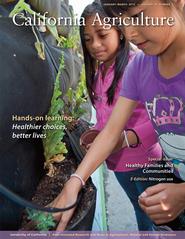All Issues

Hands-on learning:
Healthier choices,
better lives
Cover:
Garden-enhanced nutrition education increases children's fruit and vegetable intakes, helping to address high childhood obesity rates (page 30). Research indicates that long-lasting improvements are achieved through multiple efforts — offering healthy foods on school campuses; teaching nutritional and environmental science in the context of gardening; and involving communities and regional agriculture (see pages 13, 21). Shown are students tending their vertical garden at Downtown Value School in Los Angeles. The school also has a flower and produce garden that goes around the school grounds, a small greenhouse and a worm compost bin. Photo by Peter Bennett/Green Stock Photos.
January-March 2013
Volume 67, Number 1
Volume 67, Number 1





